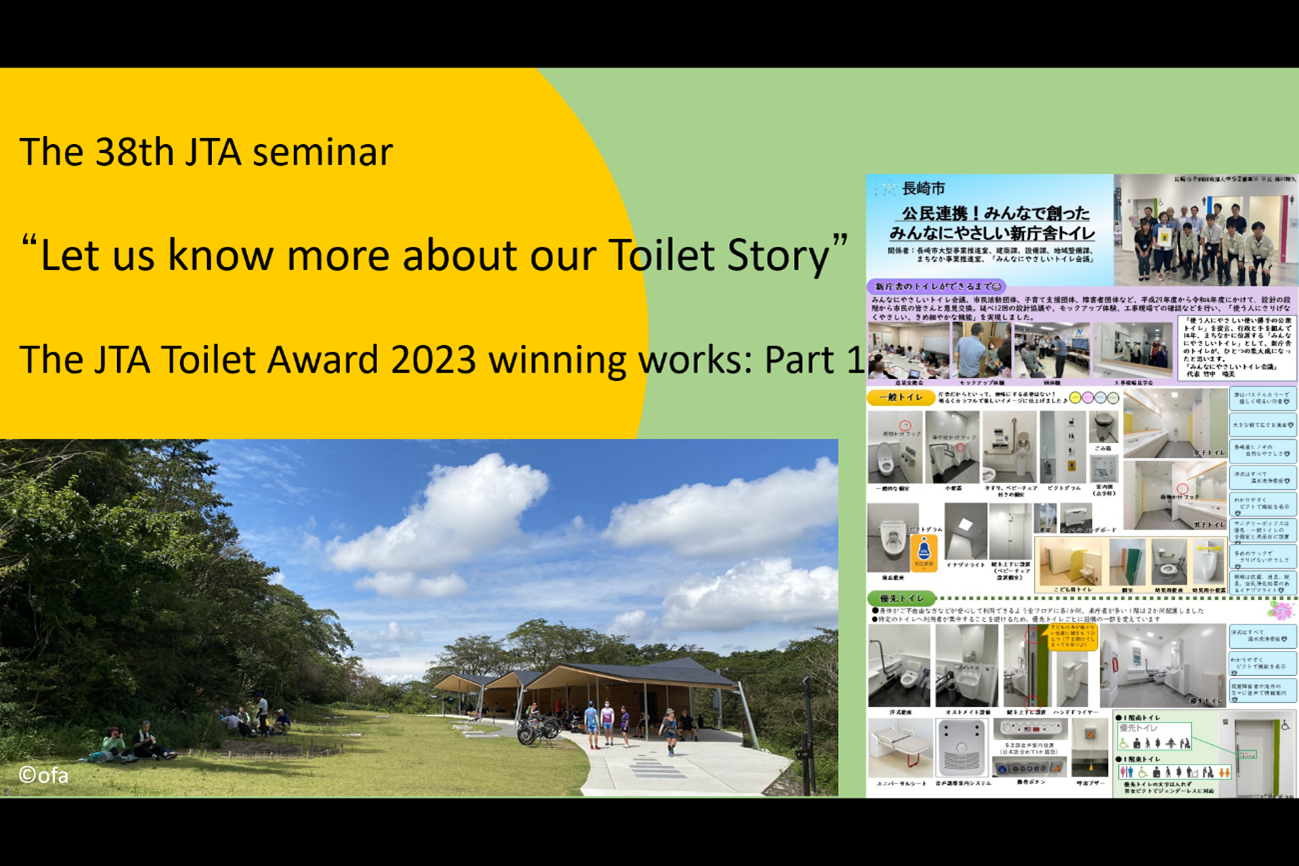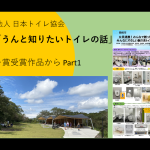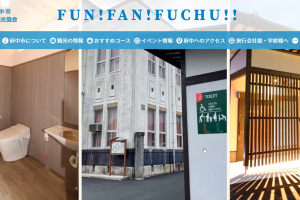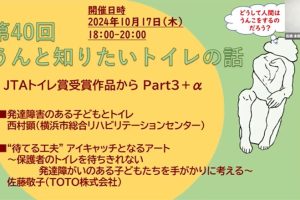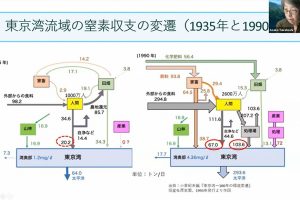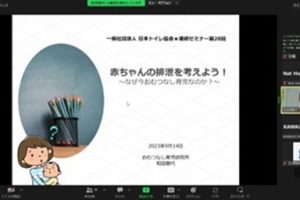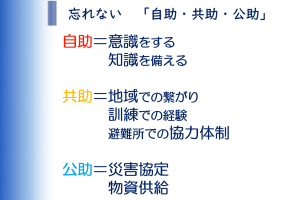Referring to the JTA Toilet Award 2023 winning works: Part 1
Presenter・Moderator
- 1 The rest space on the top of the mt. Rokko
Kenichi Ohara, Ayako Fukagawa (ofa Co.,Ltd.) - 2 Public-Private Collaboration! A New City Hall Toilet Created by Everyone, friendly to Everyone
Yuko Baba (Nagasaki City), Harumi Takenaka (Toilet for Everyone Conference) - <Moderator>Mikiko Takahashi, Ph.D. (Director of JTA, Manager of R&D Division of Comany Inc.)
Presentation Outline
Background and outline of the JTA Toilet Award
(Moderator: Takahashi)
Thank you all for joining us today. We would like to begin the 38th session of “Let us know more about our Toilet Story.” I am Takahashi from the Japan Toilet Association, and I will be serving as today’s moderator.
In this session, we will hear presentations on two projects that received the JTA Toilet Award 2023.
The first presentation will be given by Mr. Ohara from ofa Co., Ltd., who will introduce a newly constructed mountain toilet in the Rokko area, completed in 2021, with a focus on its harmony with the natural environment and efforts toward sustainability.
The second presentation will be delivered by Ms. Baba from Nagasaki City, together with Ms. Takenaka from the Toilet for Everyone Conference, who has long been engaged in public toilet improvement through citizen volunteer activities. They will talk about the new Nagasaki City Hall toilet, which incorporates the voices of citizens and reflects careful attention to detail to make it user-friendly for all.
Before we move on to the presentations, we would like to invite Ms. Azai from the Japan Toilet Association to give a brief, five-minute introduction to the JTA Toilet Award.
(Azai)
I am Azai from the JTA Toilet Award Committee. Let me briefly explain the background and outline of the JTA Toilet Award.
This award recognizes individuals and organizations who have carried out or proposed outstanding initiatives with the goal of creating toilet environments that everyone can use comfortably, anytime and anywhere, and of building a society where such environments can be sustained.
The history of the award dates back to 1985, when the Japan Toilet Association was founded. At that time, it began as the “Good Toilet 10,” which primarily highlighted good examples of public toilets, with the aim of raising awareness and improving the overall environment.
Later, the scope was expanded to include not only the physical facilities but also activities related to maintenance and awareness-raising aspects, and the award was renamed the “Good Toilet Commendation.” In 2021, as the range of initiatives broadened, the award was reorganized into four categories:
A: Production Category
B: Writing / Research Category
C: Maintenance/Management/Operation Category
D: Social Activity Category
Following this restructuring, the award was renamed the “JTA Toilet Award” beginning in 2023.
In addition to the JTA Toilet Award in each category, there is also a “Grand Prize” for particularly outstanding work, as well as special awards such as the “Incentive Award” and the “Student Award”. Furthermore, there is a “Public Voting Award”, decided not by the judges but by the votes of participants at the Toilet Symposium.
Recipients not only receive a certificate but also gain recognition from experts in the field of toilets, and their achievements are widely publicized through the association’s website, newspapers, and professional journals.
Today’s presentations are also an excellent opportunity to learn about the initiatives of award recipients, and I hope they will inspire future applications.
The rest space on the top of the mt.
(Moderator: Takahashi)
Thank you very much. Now, let us move on to the first presentation. We will hear from Mr. Kenichi Ohara of ofa Co., Ltd., who will speak about the rest space on the top of the mt. Rokko. This project received the Incentive Award in the Production Category.
The jury praised it with comments such as: “Under the CLT panel roof, which evokes the ridgeline of the mountains and the continuity of the tree canopy, a comfortable space has been created,” and “The use of local timber, together with the consideration for sustainability-such as the use of rainwater and recycled water in a site without water and sewage infrastructure, as well as natural light and ventilation-fits very well with the overall concept.”
With that, I would like to invite Mr. Ohara to begin his presentation.
(Ohara)
Thank you very much for having me today. I would like to talk about the rest space on the top of the mt. Rokko, which received the award. Our office is located at the foot of Mt. Rokko in Kobe, and it is run by just the two of us, myself and Ms. Fukagawa.
The rest space on the top of the mt. Rokko was planned as a rest space that harmonizes with the natural environment of Mt. Rokko, featuring a folded roof and a Kusahara (grassy field) landscape. The site is located near the summit of Mt. Rokko, along a popular hiking course where up to 2,000 people may pass on a busy day. However, the area has no water supply or sewage infrastructure. The challenge, therefore, was to create a toilet that is both comfortable to use and requires minimal maintenance.
Before construction, the site was simply a flat area covered with gravel, without any proper resting place. Our goal was to design a facility that balances people and nature, while achieving both sustainability and a sense of attraction.
Specifically, we introduced a system in which the folded roof collects rainwater, which is then used for handwashing. Wastewater is purified through a soil microbial biofilm combined treatment tank and reused for toilet flushing.
The architectural concept was to create a toilet that is like a piece of furniture, where wind and light can freely flow through. Under a large eave, the toilet units are arranged like furniture, with slanted walls that provide comfortable bench seating. The toilet cubicles are gathered in the center, which not only secures a circulation route and enhances safety, but also protects the toilet bowls from the severe winter cold.
For materials, we used CLT panels made of cypress and cedar from Hyogo Prefecture for the roof and some exterior parts used thinned wood from the Rokko mountain range. In addition to the architecture, we developed an integrated landscape by planting native grasses to form a Kusahara field, and we also held planting workshops.
As a result, we feel that the site has become a pleasant place where visitors can relax in their own way and enjoy the natural surroundings.
(Moderator: Takahashi)
Thank you very much, Mr. Ohara. I was truly impressed-it is such a beautiful toilet that one would hardly expect to find on a mountain. We have received some questions. The first one is from Chairperson Kohei Yamamoto of the Japan Toilet Association: “What is the capacity of the rainwater storage tank? Can rainwater alone cover the water needs of a toilet of this scale?”
(Ohara)
The rainwater storage tank has a capacity of 5 tons. The size was determined based on calculations of expected user numbers at the design stage, so in principle, it should be sufficient. Of course, if there is no rainfall for an extended period, there is a risk of shortage. In such cases, a drought warning is issued, and water is supplied by tanker trucks. So far, I have not heard of frequent shortages.
(Moderator: Takahashi)
Thank you. Here is the next question: “Since this toilet is used by hikers, some people might wash their shoes there. Were there any special considerations regarding hygiene or ease of cleaning?”
(Ohara)
Inside the toilet floor, in order to prevent water accumulation and mold growth, cleaning is generally done using a dry method. We have not provided a designated place for washing shoes. As for mud tracked in from the trails, the main cleaning is sweeping, which is carried out once a week.
(Moderator: Takahashi)
Next, we have a question from Ms. Shirakura. There are two parts: “Does the treatment tank require sludge removal?” and “When the water level decreases, I understand a sensor sends an alert-where does that notification go?”
(Ohara)
Regarding the septic tank, there is an underground primary treatment tank where non-degradable waste is collected. That waste is removed manually through a manhole. Materials that can decompose naturally are allowed to infiltrate into the soil. As for the sensor, alerts are transmitted to a nearby Forest Office. We have installed Wi-Fi, which enables the notifications to be sent there.
(Moderator: Takahashi)
Thank you. One more question: “Are there two multi-purpose toilet rooms in the center?”
(Ohara)
There is only one multipurpose toilet in the center. The adjacent space is used as a machine room for the treatment tank and the rainwater circulation system. The multipurpose toilet is also equipped with a simple ostomate facility and a baby changing station.
Public-Private Collaboration! A New City Hall Toilet Created by Everyone, friendly to Everyone
(Moderator: Takahashi)
Thank you very much. Next, we will hear about the toilet in the new Nagasaki City Hall, presented by Ms. Harumi Takenaka from the Toilet for Everyone Conference and Ms. Yuko Baba from Nagasaki City. This project received the JTA Award in the Social Activitiy category.
The jury commented: “This is a toilet created through the results of as many as 12 discussions involving citizens and users,” and “It can also be highly valued as a model of citizen participation in the creation of public facilities.”
Now, I would like to invite Ms. Takenaka to begin.
(Takenaka)
Thank you. My name is Harumi Takenaka from the Toilet for Everyone Conference. This initiative represents the culmination of 14 years of joint efforts with the city office.
The starting point actually goes back 35 years, when I organized a women-centered walking tour of the city. At that time, dirty toilets were taken for granted, but since restrooms are essential for such walks, I carried out a survey and submitted a report to the city office revealing the harsh reality. That was the beginning of my relationship with the local government.
Later, a remark from the mayor at the time-“It’s no good if you’re the only one passionate about this”-became the impetus for launching the Toilet for Everyone Conference in 2010. The initiative brought together three perspectives: those of the users, the providers (the city administration), and experts.
With the theme “Toilets as Part of Community Development,” we made concrete proposals such as installing bag hooks at washbasins, adding hooks in multi-purpose toilets and installing benches, and more. In particular, when we learned that patients who perform self-catheterization were struggling to find a place to set down their catheters, we worked together with professors at Nagasaki University to study the issue. As a result, we introduced a specially designed wide-front toilet seat that makes catheterization easier, along with the CIC mark indicating its availability.
What I value most is that these improvements were realized through discussions with the city office from the design stage, and that, over 14 years, we built a trusting relationship in which even when staff members were reassigned within the administration, the knowledge and commitment were reliably passed on. That continuity is, in my view, the greatest achievement.
(Baba)
My name is Yuko Baba from Nagasaki City Hall. Our new city hall opened in January 2023. During the planning and construction, we held a total of 12 rounds of discussions with many groups, including members of the Toilet for Everyone Conference, child-rearing organizations, and disability groups.
Based on their suggestions, we incorporated features such as placing the toilets in a location visible from the entrance, installing double locks to prevent children from accidentally unlocking doors, adding hooks beside the men’s urinals, and providing full-length mirrors.
Instead of the plain white interiors often seen in public facilities, we chose pastel-colored doors to create a warm and cheerful atmosphere. This was my own strong request after seeing the pamphlet proposed by the design contractor, because I wanted the toilets to feel welcoming.
For the accessible toilets in particular, we conducted repeated reviews using mock-ups and VR simulations. Adjustments included using contrasting colors between walls and handrails for people with visual impairments, and placing hooks at positions where items can be easily reached while seated. Even details such as coat hooks as door stopper were lowered from the original design to make them easier for shorter people to use.
We will continue to value the opinions we receive to ensure that these facilities remain user-friendly for everyone.
(Moderator: Takahashi)
Thank you very much. Holding as many as 12 meetings must have been quite a challenge. We now have a question: “Why were gender-neutral toilets installed only on the east side of the building?”
(Baba)
We received feedback from disability organizations that genderless individuals may appear non-disabled, and if such people use priority toilets intended for persons with disabilities, it can lead to complaints or even disputes. Therefore, we divided the functions: on the east side we installed toilets that anyone can use, while on the south side we installed toilets that are prioritized for people with disabilities and others who may need them. That said, it does not mean that others are strictly prohibited from using them; instead, we use the softer expression “priority toilet.”
(Moderator: Takahashi)
Next question: “You mentioned that the project began with women’s walking surveys of the city. Are there any particular considerations for men’s toilets?”
(Takenaka)
Yes, men also carry shoulder bags, so we installed hooks next to the urinals. These have become very popular, as they are also convenient for hanging canes or umbrellas. We also learned that men often take off their coats before entering a cubicle, so we placed hooks at a higher level so coats would not touch the floor. Through years of research, we’ve realized how different usage patterns are between men and women.
(Baba)
For men’s toilet cubicles as well, we designed the lining space (the area behind the toilet bowl) to be wide enough so that personal belongings can be placed, providing a space comparable to that of women’s toilets.
(Moderator: Takahashi)
Finally, we have a question: “When gathering citizens’ opinions, what kind of approaches are necessary, and how do you form differing viewpoints?”
(Baba)
Instead of showing technical drawings as they are, we redrew them in a simplified form to make them easier to understand. For suggestions that could not be adopted, we carefully explained the reasons. Rather than concluding discussions with each group after just one meeting, we engaged in multiple rounds of dialogue to ensure that everyone could understand and agree with the outcomes. As a result, we received not so much opposition but many valuable suggestions on what should be included, which allowed us to successfully incorporate them into the design.
(Moderator: Takahashi)
Thank you very much. This concludes the presentations from both of you. Listening to your talks, I am always inspired by your passion for toilets. We encourage everyone to consider applying for this year’s JTA Toilet Award. Thank you all for attending today.
